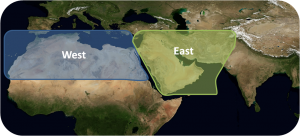This week we’ll finish our look at the climate summaries for each GLOBE region with a focus on the Near East-North Africa region. Remember that these annual reports provide a summary of the global climatic conditions and are a great benchmark for monitoring climate.
Regional reports provide a tremendous amount of information. The temperature and precipitation climate summaries are highlighted here, but if you are interested, more information about the Near East-North Africa region state of the climate is available from this website: http://www1.ncdc.noaa.gov/pub/data/cmb/bams-sotc/2010/bams-sotc-2010-chapter7-regional-climates-lo-rez.pdf
The Near East-North Africa region is different from most regions in that the region is mostly desert. Even so, we’ll take a look at the Near East-North Africa region in two sectors: east and west.
Temperature
The west sector includes the GLOBE countries of: Egypt, Mauritania, Morocco, and Tunisia.
For 2010, the west sector was exceptionally warm, observing temperature anomalies of +1 to +3 degrees Celsius. Places like Morocco saw daily maximum temperatures exceeding 47 degrees Celsius!
The eastern sector includes the GLOBE countries of: Bahrain, Jordan, Kuwait, Lebanon, Oman, Pakistan, Qatar, Saudi Arabia, and the United Arab Emirates.
Temperatures in the east were also warmer than average across the entire sector. The Saudi Arabian Peninsula, for example, experienced temperature anomalies ranging from 0.5 to 2 degrees Celsius above average.
Precipitation
In the west sector, 2010 was a very wet year. In the summer, the Chefchaouen region of Morocco experienced devasting forest fires during the months of July and August, when temperatures were at their highest. With the onset of fall and the subsequent winter, especially wet conditions led to flooding in localized areas of Morocco and Tunisia in October and November.
In the east, there were areas that received increased precipitation and others that had below average precipitation. The Saudi Arabian peninsula was an area with below average precipitation in 2010; however, just to the east and north, Pakistan experienced the worst flooding in their history. The flooding was due to an exceptionally strong Asian monsoon, which is a circulation pattern that carries moist air from the Indian and Pacific Oceans into Asia. The monsoon was stronger than usual due to La Niña conditions in the equatorial Pacific. Even though La Niña occurs thousands of miles away, it has a global influence on weather and climate.
To learn even more about the state of the climate in 2010 for the Near East-North Africa region, please find more detail in the actual report summary: http://www1.ncdc.noaa.gov/pub/data/cmb/bams-sotc/climate-assessment-2010-lo-rez.pdf.
Does your record of GLOBE data for the past year show any similarities to the summary provided here? Have you had any significant events have you in your local area? Please share them with us through the comment option below!
We hope you enjoyed our journey through the six GLOBE regions as we examined the state of the climate for 2010. Each region is important to the overall balance of the earth system and is has interconnected climates. As GLOBE students working together to collect data and conduct research investigations in your area, you will help us better understand the climate system!
-jm

